Why change your own oil?
One of the cornerstones of do-it-yourself car maintenance jobs is the home oil change. It's a simple process that requires few tools, and it's a sure way to save some money while you avoid the hassle of sitting in a dull waiting room somewhere reading outdated magazines.
More than anything, the basic oil change is a great way to connect with your vehicle and take some control over its maintenance. The time you spend under the hood and under the car affords you an excellent opportunity to look around and see if anything else needs attention.
Our video shows the process in action:
Money Saved: Between $25 and $75
Time Required: One hour the first time out; 30 minutes on average
Tools Required:
- Wrench to remove drain plug (box end or socket)
- Oil filter wrench
- Oil drain pan
- Funnel
- Latex gloves
- Jack and jack stands or ramps (optional, depends on ground clearance)s
Materials Required:
- Oil
- Oil filter
- Replacement drain plug washer (depending on application)
Let's get started.
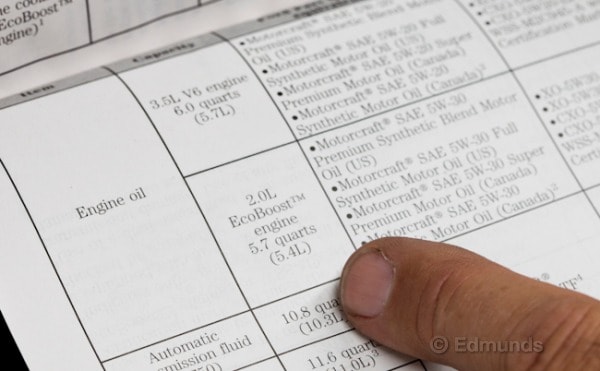
Steps for changing your oil
- Check the type and amount of oil needed
- Get together your filter, wrenches, and other supplies
- Prepare your vehicle
- Locate the oil filter and drain plug
- Drain the oil
- Tighten the drain plug
- Change the oil filter
- Add the new oil
- Check the oil level
Check the type and amount of oil needed
Before heading to the auto parts store to buy supplies, consult the owner's manual to confirm the type and amount of oil that's required.
The amount is easy. Here, our 2012 Ford Explorer requires 5.7 quarts, so I'll buy six. Five-quart jugs are tempting because they are cheaper than smaller sizes, but I find them heavy and hard to pour steadily. And a huge container of leftover oil will take up a lot of shelf space.
Make sure to match the oil's viscosity to your engine. The 2.0-liter Ford EcoBoost requires 5W-30 oil. If I had read the manual carelessly, though, I could easily have brought home 5W-20 instead. That's the oil specified for the 3.5-liter V6 engine.
Check to see if the manual calls out other specific oil requirements as defined by the by the American Petroleum Institute (API) and the International Lubricant Standardization Approval Committee (ILSAC.) Sometimes synthetic oil is expressly called for. Sometimes it's not necessary. And sometimes its use is implied by additional requirements.
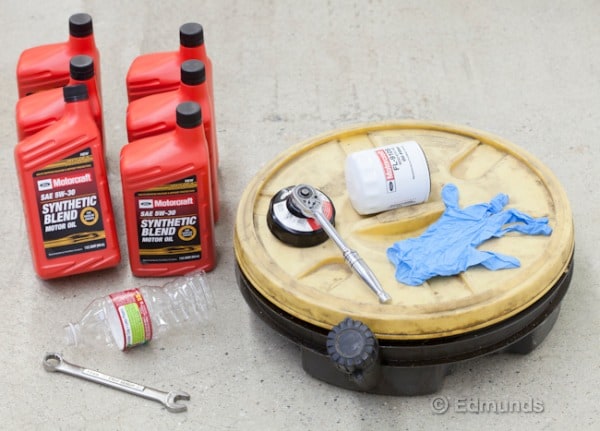
Get together your filter, wrenches, and other supplies
In addition to oil, you'll need an oil filter, an oil-filter removal wrench, a wrench to remove the drain plug, a funnel, a drain pan and some gloves. You may also need to raise the car to gain access, in which case you'll need a floor jack and safety stands, or a pair of purpose-made steel ramps. For this kind of work, never use the flimsy jack that's supplied with the car.
Yes, my funnel is an empty, dry water bottle with the end cut off. Also, my drain pan has a screw-on lid and pour spout, which makes it easier to transport and recycle the old oil. The only other "tools," not shown here, are a T-shirt and grubby jeans.
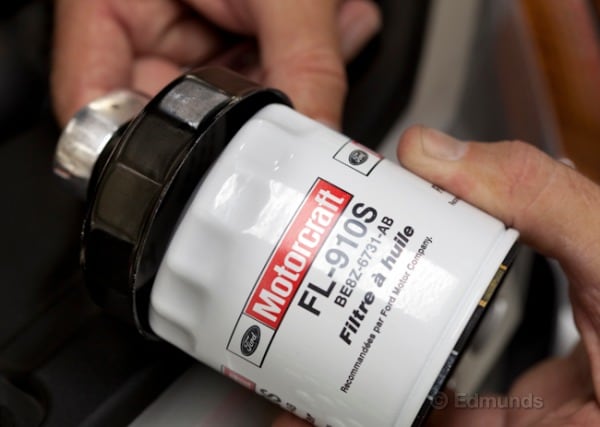
You can buy filters at the dealership or at an auto parts store. Make sure to ask if you'll need a new drain plug washer. Some dealers automatically include a new washer, if you need one. Others charge extra for it. In this case, I didn't need a new washer, as you'll see later.
I like the sort of filter wrench that engages the serrations on the end of the oil filter. Wrenches like that are available at most auto parts stores for a few dollars and they snap onto the end of any common three-eighth-inch-drive ratchet. There are many sizes, but it's easy to make sure you buy the right one if you match the wrench to the filter right there in the store.
Band-type filter wrenches are more familiar, but they can be frustrating to use if you don't have enough space — especially if the old filter was over-tightened.

Prepare your vehicle
Your engine and its oil should be warm when you get started, but not hot. Let the car sit so the exhaust system cools off some, but don't allow things to go stone cold.
If you need to raise the car for better access, this is a good time to do it. Make sure you install proper safety stands, of course. Oftentimes you don't need to remove tires, but I did it anyway so our photographer, Elon Schoenholz, could have a clear view of things.
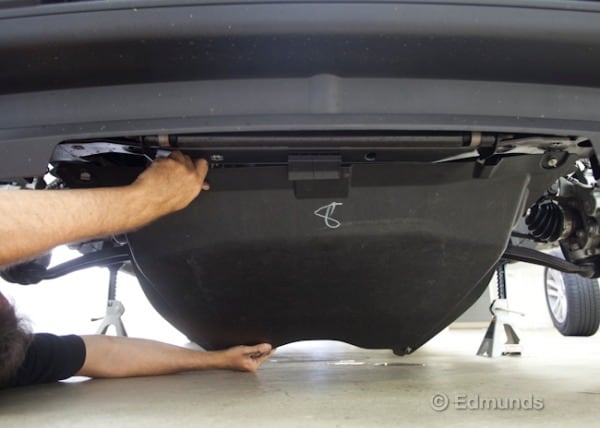
If necessary, take off the undercover. Some newer cars have these aerodynamic covers to improve fuel economy and keep things clean. Unfortunately, the covers can hide the engine's oil drain plug and oil filter. Some covers have built-in access hatches and they're usually labeled. Sometimes you have to remove the undercover entirely. The good news for us DIYers is that most cars don't have them. The Explorer does, but it's held in place with four twist-release clips that don't require any tools for removal.
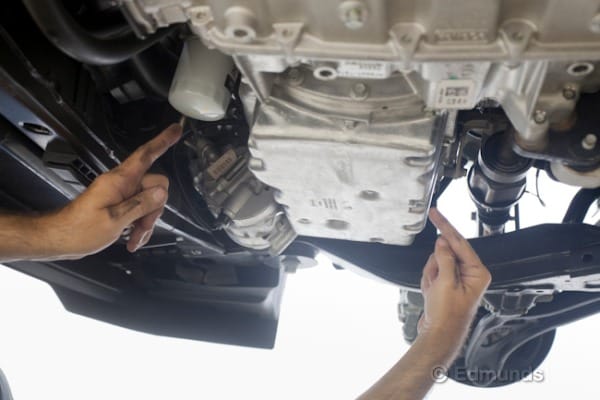
Locate the oil filter and drain plug
Now it's time to locate the oil filter and drain plug. The vast majority of cars have a bottom-mount screw-on filter, such as the one shown here.
In this case, the plug and filter are far apart, meaning I must reposition the drain pan after I drain the oil and before I remove the filter. For this reason, I'm going to completely finish draining and replugging the engine before I work on the filter. If these elements were closer (or if my pan were bigger) I could begin removing the filter while the last of the oil was still dribbling out.
If yours is one of the growing numbers of new cars with a top-mount cartridge filter, the following oil-drain and refill steps are the same, but the filter change process is not. I'll cover the process for changing a top-mount cartridge filter in another piece.
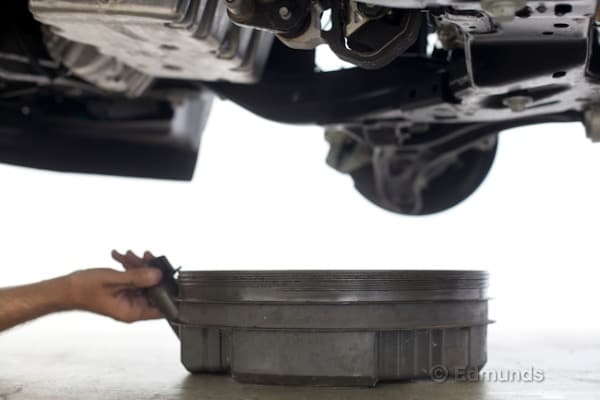
Drain the oil
With the preliminaries out of the way, it's time to drain the oil out of the engine. It's important to place the drain pan under the drain plug — but not directly under it. The angle of the drain plug will cause the oil to stream out at an angle, so I'm offsetting the pan to that side by several inches. If I were doing this outdoors, I would also account for wind. No, really. Those last wispy ribbons of oil can blow around and make a mess.
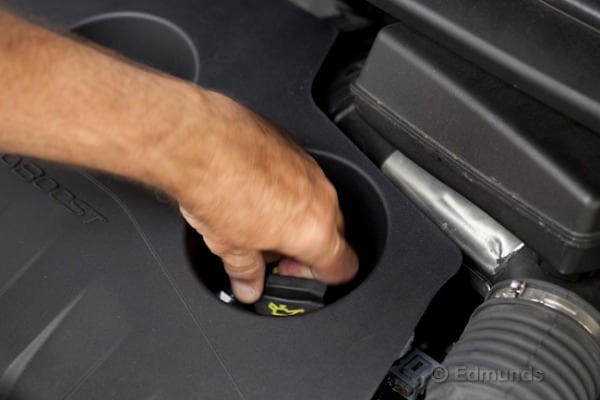
Remove the oil filler cap. You've held your thumb atop a drinking straw filled with water to keep it from running out, right? It's not quite the same here, because oil would still drain with the oil filler cap on, but it does seem to flow out more smoothly and quickly with the cap removed. If nothing else, taking the cap off now serves as a reminder to put the new oil in before you start the engine.
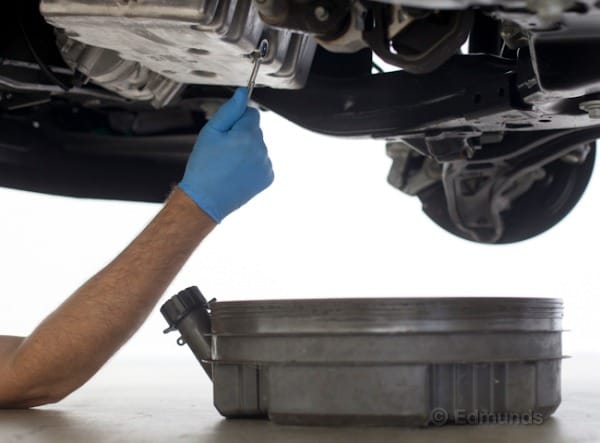
It's time to put the gloves on. When you remove the oil drain plug, things start getting messy.
You can usually remove the drain plug with a common end wrench and a bit of muscle. The hex end on a typical drain plug is almost always a common size that comes in a standard tool assortment, but even the domestic carmakers tend to use metric in the 14-17mm range. A three-eighth-inch drive ratchet is perfectly fine, of course, as long as you remind yourself not to use its extra leverage to over-tighten the drain plug when you put it back later.
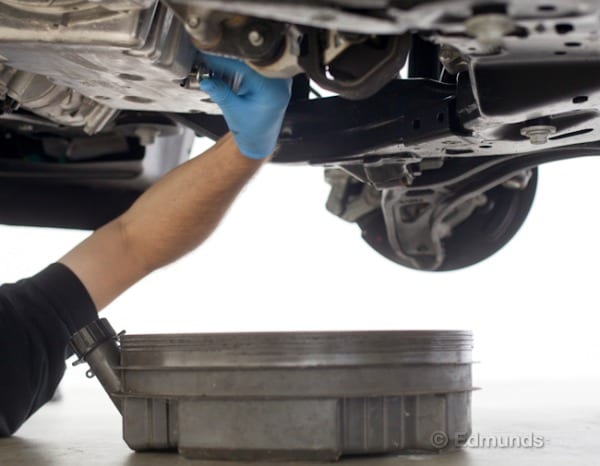
Go slowly as you remove the drain plug and keep your hands away from the expected path of the oil. It's going to come out quick and warm. If you miscalculate, it could dribble down your arm. This is another reason why it's best not to change oil when the engine and its oil are piping hot.
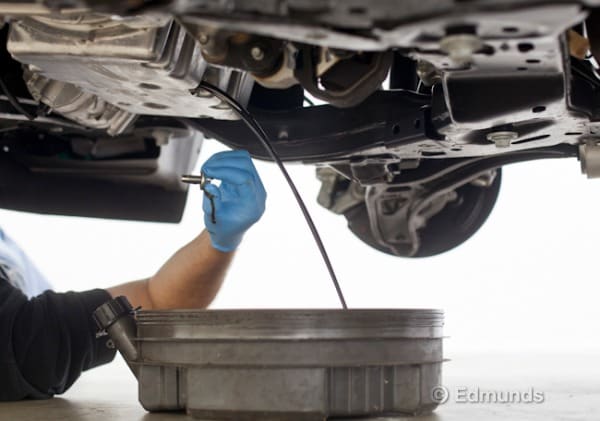
I almost got away clean, but not quite. On the other hand, I usually fumble the drain plug into the pan as the oil comes out. Not this time.
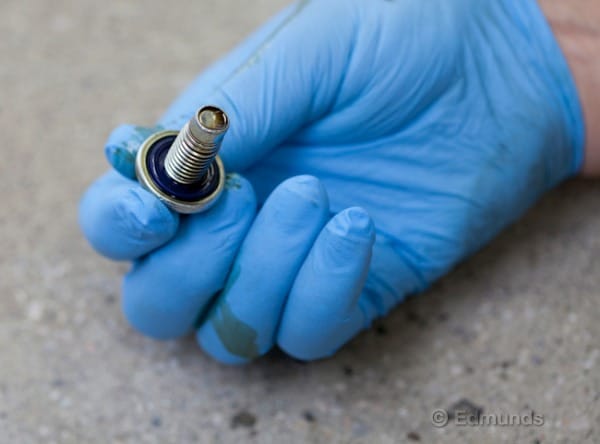
Tighten the drain plug
Inspect and clean the oil drain plug while the rest of the oil is draining. This is where the new drain plug washer would go if one were needed. But as you can see, this one has a permanent O-ring instead. If your drain plug does need a replacement washer, make sure the old one isn't stuck to the engine's oil pan — you don't want to inadvertently stack a new washer atop the old one.
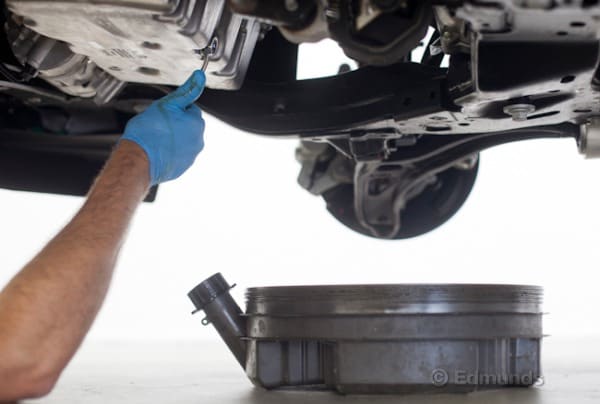
Tighten the drain plug. Theoretically, there is a torque specification for drain plugs, but they're almost never published in the owner's manual. Even if you do find the spec, it's unlikely that the half-inch drive torque wrench you bought to tighten lug nuts will go low enough for this job.
The drain plug is properly tightened if you use the box end of a combination wrench and tighten it as much as you can without using a hammer or slipping a pipe over the wrench for extra leverage. A standard-length three-eighth-inch drive ratchet will work if you choke up on it a bit, but anything longer or larger can lead you down the path of over-tightening. You want the bolt to be tight, but you don't want to strip it out.
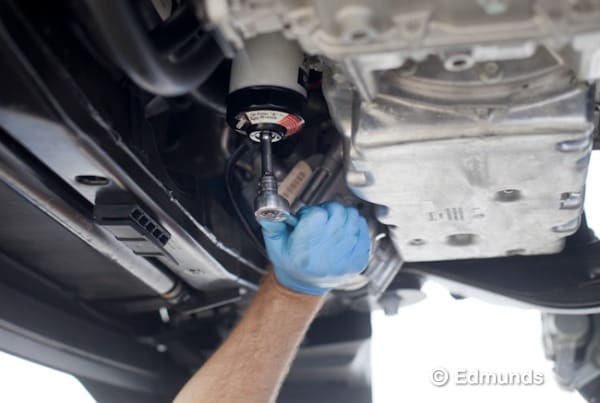
Change the oil filter
Remove the oil filter. New filters that are properly installed don't go on terribly tight. But they can be hard to get off later because their sealing gaskets swell over time.
Here I've added an extension to my ratchet to get a little extra knuckle room. But I'm not going to use the wrench much beyond the point of breaking the filter free. Filters loosen in a hurry, at which point oil starts to gush out all around the perimeter. Go slowly and switch to unscrewing the filter by hand as soon as you can.
Unlike drain plug removal, there is no way to avoid making a mess at this stage. Make sure you reposition the drain pan before you start. Have rags handy and prepare to get some oil down your arm. Don't let go of the filter once it starts to come off.
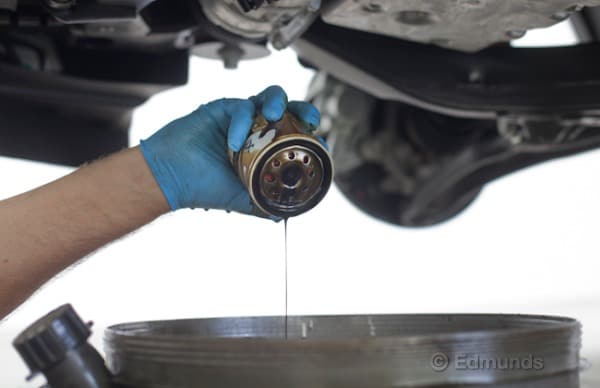
Hold the filter over the pan to drain it, but try not to drop it in. It makes a very messy splash.
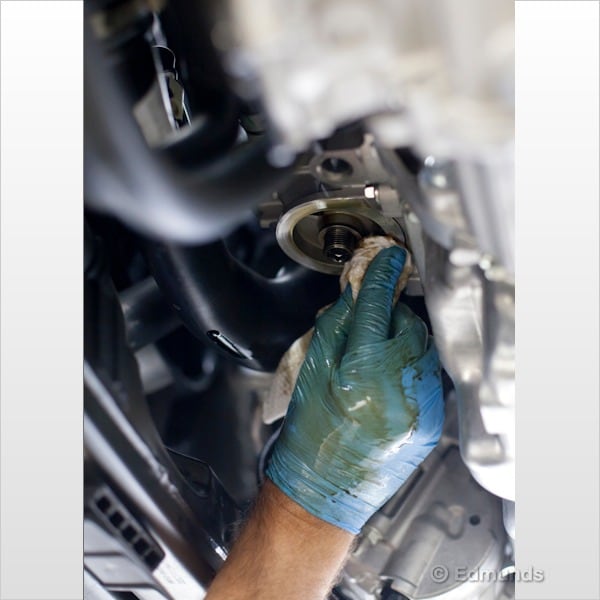
Use rags to clean as much oil away as you can, paying special attention to the filter sealing surface. Make sure to remove the old filter's O-ring if it stuck itself to the surface. This rarely happens nowadays, but it's one of those things you check anyway because a double stack of O-rings won't seal, allowing your new oil to pump out and ruin your engine.

The last messy step involves smearing a dab of new oil on the new filter's O-ring.
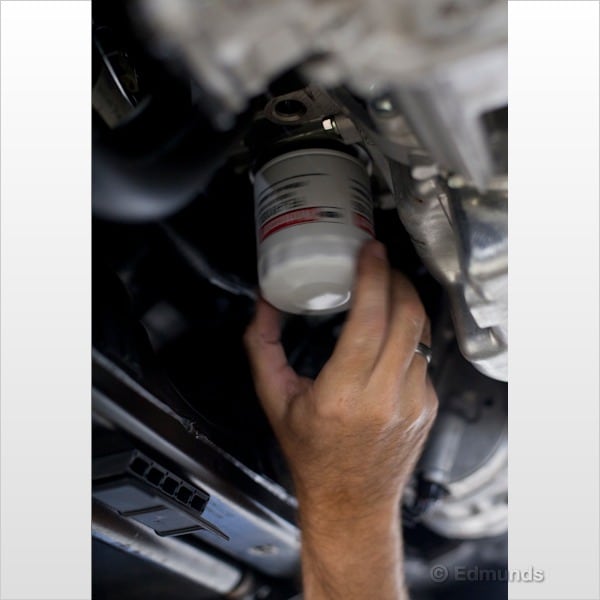
Install the new filter. At this point I like to take the gloves off so I get a good grip. I'm spinning the filter on gently until the O-ring makes first contact with the sealing surface.
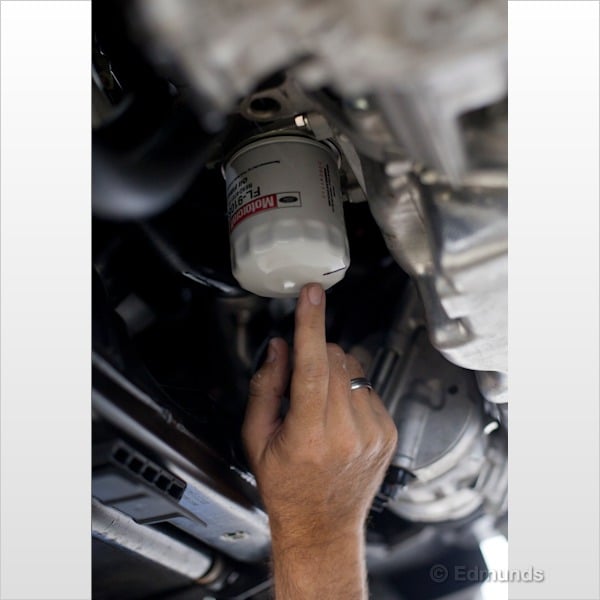
Before I tighten the filter, I draw a reference line on it with a marker or paint pen. Generally, oil filters are tightened no more than three-quarters of a turn to a full turn beyond the point where the O-ring first contacts the sealing surface. Consult your manual or the oil filter box to confirm the proper amount.
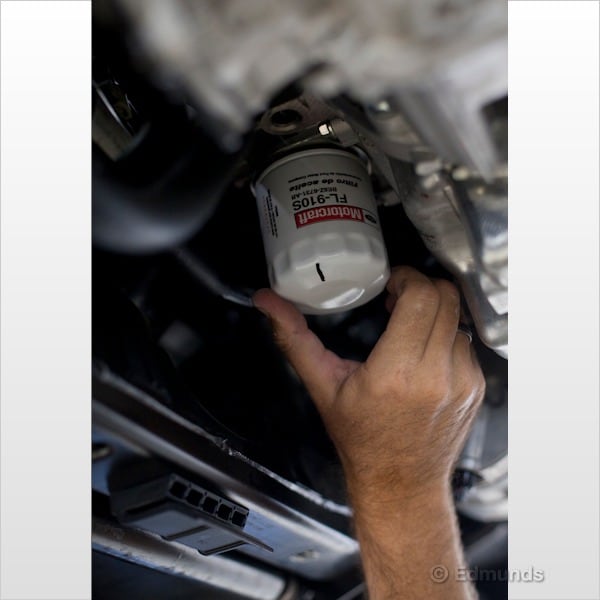
Here I'm at three-quarters of a turn with no tools. This is enough. You can go to a full turn if you can manage it by hand, but don't resort to a filter wrench just because you want to tighten it more than the recommended amount. In most cases you'll only need a filter wrench for tightening if access is too tight or if your hands are too oily for a solid grip.
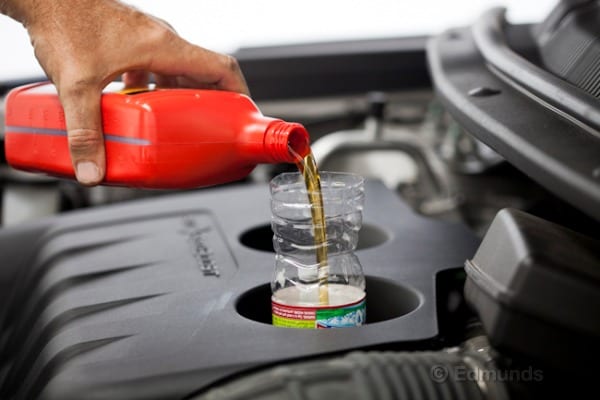
Add the new oil
After you reconfirm that the oil drain bolt and filter are both in place and properly tightened, it's time to add oil. Add approximately one quart less than the recommended amount. Ford's EcoBoost 2.0 engine requires 5.7 quarts, so I'm adding five now and holding the last one back for later. I also like to hold the bottles on their side for a smooth pour.
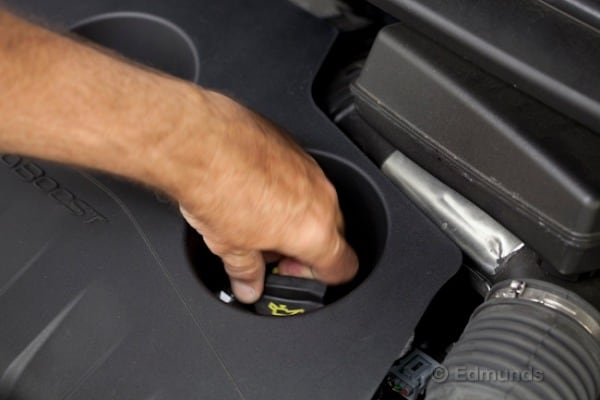
Now it's time to replace the oil cap and start the engine. Run the engine for 30 seconds or so to circulate the new oil, then shut it down and check your work area underneath the car for leaks.
Once you're satisfied that everything is OK, lower the car off the jack stands or ramps.
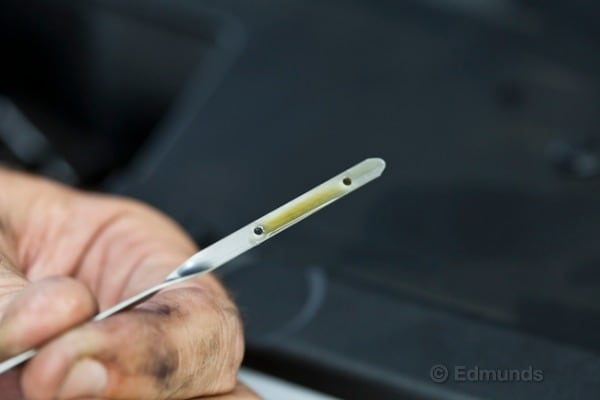
Check the oil level
Now that you're on flat ground, check the oil level. Because I short-filled it slightly, it was no surprise that I had to add a little more oil. As usual, you'll know the level is full when the oil comes up to the upper hole or hash mark.
The only other step now is to properly dispose of the old oil and filter. Most auto parts stores that sell oil will take your waste oil at no charge. If yours won't, local municipalities often have household hazardous waste drop-off points.
That's it. We're done. Once you've done an oil change a couple times and you are familiar with your car's idiosyncrasies, the whole job takes less than 30 minutes. If you stockpile oil and filters in your garage, you'll save both time and money compared to going to a mechanic. And once you get comfortable with the basic oil change, a whole slew of other maintenance tasks begin to seem within easy reach.

 by
by 
